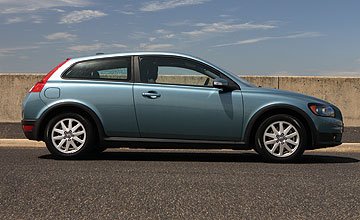BY GEORGIA OCONNELL | 13th Feb 2008

Priced from $34,450, the new S is $4000 cheaper than the previous cheapest C30, the LE, and $8000 short of the top-line T5.
Like the LE, it uses a 2.4-litre twin-cam 20-valve five-cylinder petrol engine to produce 125kW of power at 6000rpm and 230Nm of torque at 4400rpm.
Delivered to the front wheels via a five-speed manual or five-speed Geartronic automatic gearbox, it helps propel the smallest Volvo from zero to 100km/h in 8.4 seconds (auto: 8.8) on the way to a 220km/h (a: 215) top speed.
The C30 S uses a combined average of 8.4L/100km of premium-unleaded petrol (a: 9.0L/100km) and emits 200g/km (a: 214) of carbon dioxide.
This 2435cc petrol unit is also the same as that found in the Volvo S40 and V50.
Like its siblings, the S uses the same coil-over strut front and multi-link independent rear suspension system with anti-roll bars all round, electro-hydraulic powered rack and pinion steering set-up and four-wheel disc brakes.
The three-door four-seater C30 is built on the same C2 platform as the Volvo S40 and V50 models, and shares most of their underpinnings. It is built in Belgium, and is also related to the current Mazda3 and Ford Focus.
Standard features include dual front, side and curtain airbags, anti-lock brakes with EBD Electronic Brake-force Distribution and EBA Emergency Brake Assist, traction control, remote central locking with ‘Home Safe’ delayed lights-off, climate control air-conditioning, cabin pollen filter, front seat lumber support, electric and heated exterior mirrors, powered front windows, a trip computer, cruise control, tilt and reach adjustable steering wheel, front and rear fog lights, a 50/50-split rear seat and 16-inch alloy wheels.
DSC stability control adds $2190 to the price.
Over the LE, the 1437kg S loses 7kg of weight, mostly through the deletion of the $1350 enhanced audio system, $250 puddle lights and electric folding exterior mirrors, $2850 leather seats and leather trimmed steering wheel ($550) and gear knob ($200), and $80 water repellent rear-view mirrors.
Among the C30 S’ rivals are the base model BMW 116i ($34,900), Audi A3 1.6 ($33,950) and Mercedes A160 three-door hatch ($34,700). All include stability control. With DSC, the Volvo’s base ask is $36,640 – although the German cars also lack some of the features that are standard on the Swedish car, as well as its clear performance advantage.
Volvo also hopes that the C30 will attract potential buyers of the Volkswagen Golf, Honda Accord Euro, Mini Cooper, Alfa Romeo 147, Citroen C4, Peugeot 308 and Fiat Ritmo, as well as up-spec versions of the Subaru Impreza and Mazda3.
Volvo Car Australia managing director Alan Desselss revealed that he is delighted with the response last year to the C30 LE and T5, saying that the 65 sales per month recorded were around 15 units more than anticipated at the model’s March launch.
With the C30 S and turbo-diesel powered D5 now on stream, he is predicting around 75 units per month – averaging to about 900 for 2008.
For now the C30 will remain as a five-cylinder engine line-up, but the lower-priced four-cylinder models already available in Europe (in 1.6, 1.8 and 2.0-litre petrol and 1.6D and 2.0D turbo-diesel guises) may eventually be imported – although no decision has yet been made.